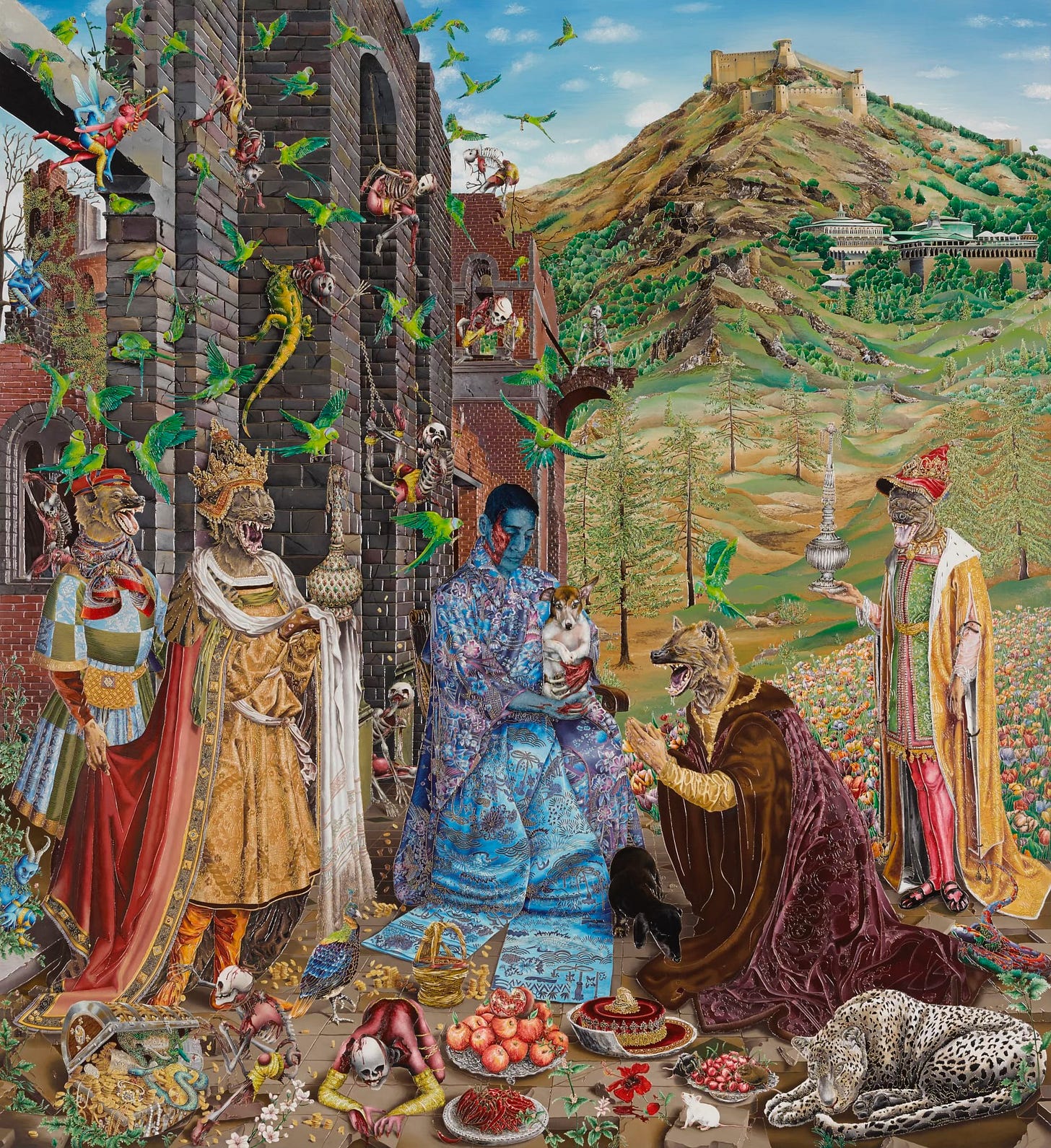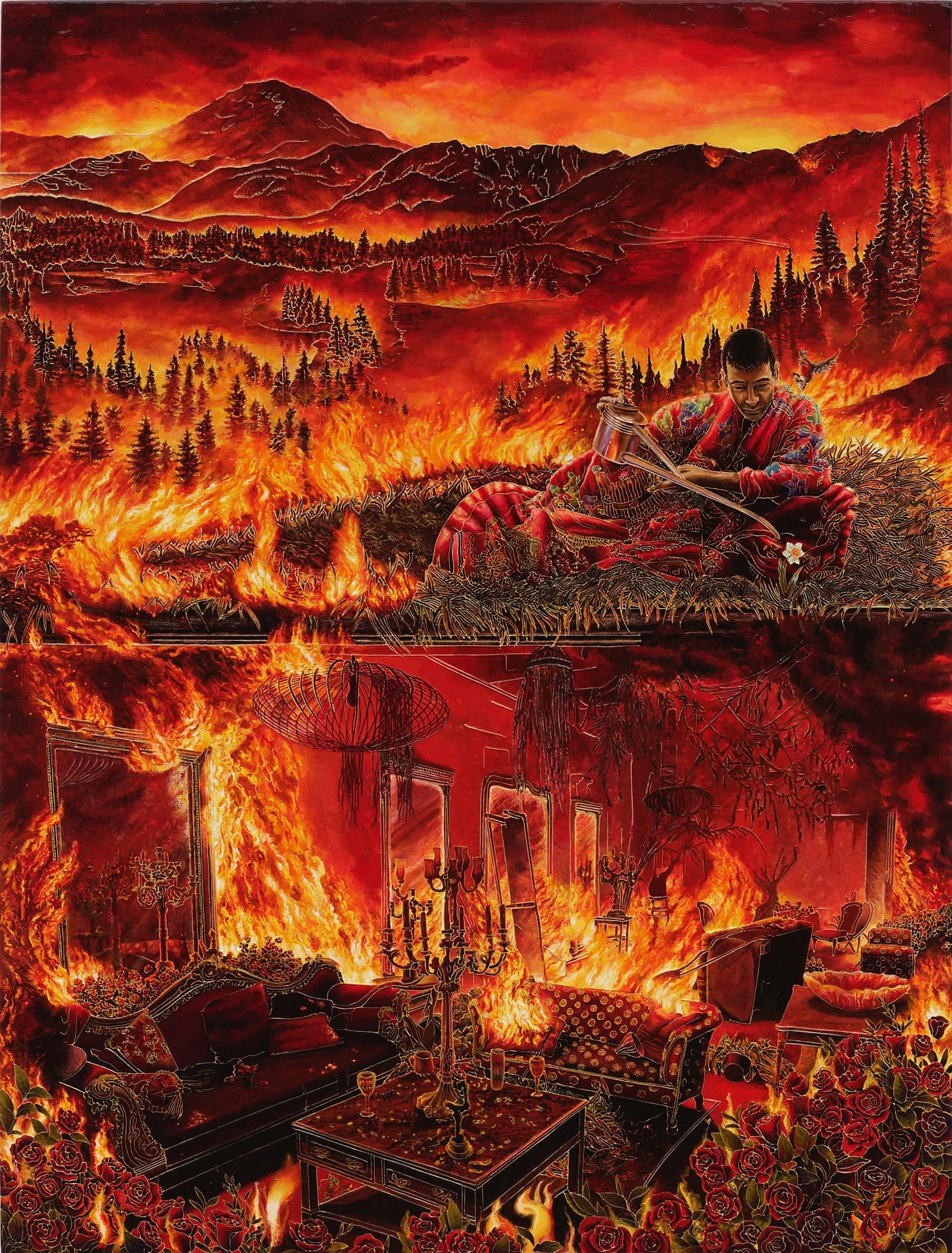Raqib Shaw: An Exhibition Review
a review on artist Raqib Shaw's exhibition Ballads of East and West shown at the Frist Museum in Nashville, TN.
This February I am exploring, albeit in a fashionably late manner considering this exhibition happened in December 2023, the work of Raqib Shaw, an exceptional visual artist from Kashmir, India who has lived in London for over twenty-five years. His work has been exhibited in The Metropolitan Museum of Art, The Pace Gallery, The Scottish National Gallery of Modern Art, The Whitworth, Galerie Thaddaeus Ropac, Manchester Art Gallery, among many other international arts organizations and museums.
I was introduced to Raqib Shaw’s work after seeing a local exhibition. After viewing Shaw’s work and digging into the research of his life and artistic practice, I’ve written an exhibition review below.
You can find more information about Raqib Shaw on his website, linked here.


Ballads of East and West: ‘Never the Twain Shall Meet’
It starts within a space of multiplicity. Taking from the revered Rudyard Kipling’s 1887 poem “Ballad of East and West”, Raqib Shaw has engulfed himself in dichotomies, rooting his exhibition Ballads of East and West in Kipling’s famous line, “there is neither East nor West” but rather a space where, as Shaw states, “East and West can meet in art”. This dichotomous space is the center of every composition in Ballads of East and West. In his youth Shaw grew up in Kashmir, India, a region enveloped by the Himalayan Mountains. Kashmir is a common motif in Shaw’s work, as the homeland he grew up knowing is a contested, fraught landscape between Pakistan, China, and India. It is a landscape wrought with strife and devastation. Having left India, Shaw relocated to London where he has lived as an artist for over twenty years. It is in this diasporic belonging, in Shaw’s dichotomies of belonging, that Ballads of East and West comes to be.
Entering the Frist Museum in Nashville, Tennessee Raqib Shaw’s Ballads of East and West exhibition presents itself as three rooms with over a dozen works by Shaw that hang on muted, blue walls. The viewers first enter the middle room, having the option to venture beyond into either of the exhibition spaces which flank each side. All three gallery spaces house around six to seven pieces ranging in size from four to eight feet tall, each squarely mounted to the wall. The pieces range in materiality, the majority of Shaw’s pieces being birchwood panels with acrylic liner and enamel, some with added stones, rhinestones, and copious amounts of glitter. Shaw took to wielding a porcupine quill to create these exemplarily hyper detailed works.
There is one sculptural work, Small Adam (2011), a bronze, ruby, and diamond adorned sculpture that is hard to look away from. In Small Adam two beings engulf one another, a beastly red lobster and hawkish, bird-like man (Shaw himself), entangled before us. The two figures are equal in size, making this work disturbing for its unnatural features and hybrid bodies. There is sheer fatality and commotion, contained into this sculptural brawl, that sits before us. It is both a collapsing into Shaw’s own person and a literal fight against himself. Small Adam highlighting the dichotomy of Shaw’s practice and the self-portraiture that marks each of his works.

Shaw’s work The Adoration (After Jan Gossaert) (2015-2016) embodies this push and pull of parts, as it creates a composition full of wild bewilderment, self-portraiture, and manipulated landscapes. Notably, The Adoration (After Jan Gossaert) points directly to the original work by Jan Gossaert’s, The Adoration of the Kings (1510-15), a composition ridden with figures, most notably the Virgin Mary and Christ child who center the piece. The Virgin draped in blue, cradling a cherub like Christ child who is being adorned with gifts by onlookers from every angle. Shaw has reimagined this work by placing himself as the Virgin and his dog, Mr. C., as the Christ child. It is intensely personal; Shaw’s body is blue and his hands grasp onto Mr. C’s tiny form as hybrid man-wolf creatures adorn Shaw with gifts. The landscape is bursting with life, as green parakeets fly above, dotting the sky, a testament to Shaw’s childhood in Kashmir. Lush green mountains cut into the sky above and two fortresses loom in the distance. The foreground of the piece is disheveled with a mixture of skeletal beings, mice, snakes, a sleeping leopard, and a peacock rummaging on the floor below. The entire composition is illuminated by a mixture of real gemstones and glitter, creating a spectacle of refracting light. The Adoration (After Jan Gossaert) feels real, as if we can walk into the landscape before us, and yet equally as dreamlike; Shaw intentionally creating this composition to note his longing for Kashmir, a landscape that no longer exists as he remembers it. The Adoration (After Jan Gossaert) collapsing deeper and deeper into itself as the viewer finds this work to be the embodiment of a past and present, real and imagined, lifelike and hybrid space.
As we journey from one piece to the next, Shaw has intimately placed his self-portraits within each work, as if calling to us that we must not lose sight of who he is now and where he came from. Each piece is composed of shimmering colors, scenes melded together from reality and imagination, creating environments that encompasses your entire line of sight. Shaw’s piece, When the Thing with Feathers Turned Red (After Tintoretto) is a grueling testament to Shaw creating compositions that entertain both real and imagined experiences. Inspired by Tintoretto’s The Adoration of the Shepherds (1578-1581), this work is split into two, exposing two fatal losses in Shaw’s life: his London studio and his beloved homeland of Kashmir. Immediately, one is struck by red, devouring flames that almost encroach into our reality. This piece is paramount to Shaw’s dichotomy of being, as Shaw has literally split the composition into two parts, yet the entirety of the work roars under fire. The work is referencing the 2017 fire of Shaw’s London studio. Is also references the burning and devastation of Kashmir, his cherished homeland that no longer remains. We are witnessing two devastations encompassed in one work, with Shaw perched in the above landscape of Kashmir looking below to his burning London studio. The only life form Shaw embraces is the flower he waters below him, a Narcissus flower, probing thoughts on both his real and imagined self. There is web after web of symbolism, rebirth, death, and dual belongings that undertone When the Thing with Feathers Turned Red (After Tintoretto). It is, arguably, the most devasting piece in this exhibition and the greatest embodiment of Ballads of East and West. Without life there is no death; without death there is no rebirth from one self to another.

Shaw states, “My use of imagery and objects illustrate my sense of displacement”. It is in this displacement that we see what Shaw both yearns for in his past and is connected to in his present. Images of his beloved dog Mr. C coupled with the ruined landscape of Kashmir reflect just that, among many other motifs that embody this dichotomy of suffering, rebirth, and paradises of imagination. Shaw chose, before anything else, to embrace his hybrid belonging, of being from Kashmir but having lived in London for over twenty years. Shaw chooses to break through these notions of ‘Never the Twain Shall Meet’ and relish in his hybrid belonging. It is, undoubtedly, a spectacular thing to witness; a feast for the eyes. Ballads of East and West truly glimmers in the distance as a moment of unity, self-expression, and creating compositions that have no bounds.



